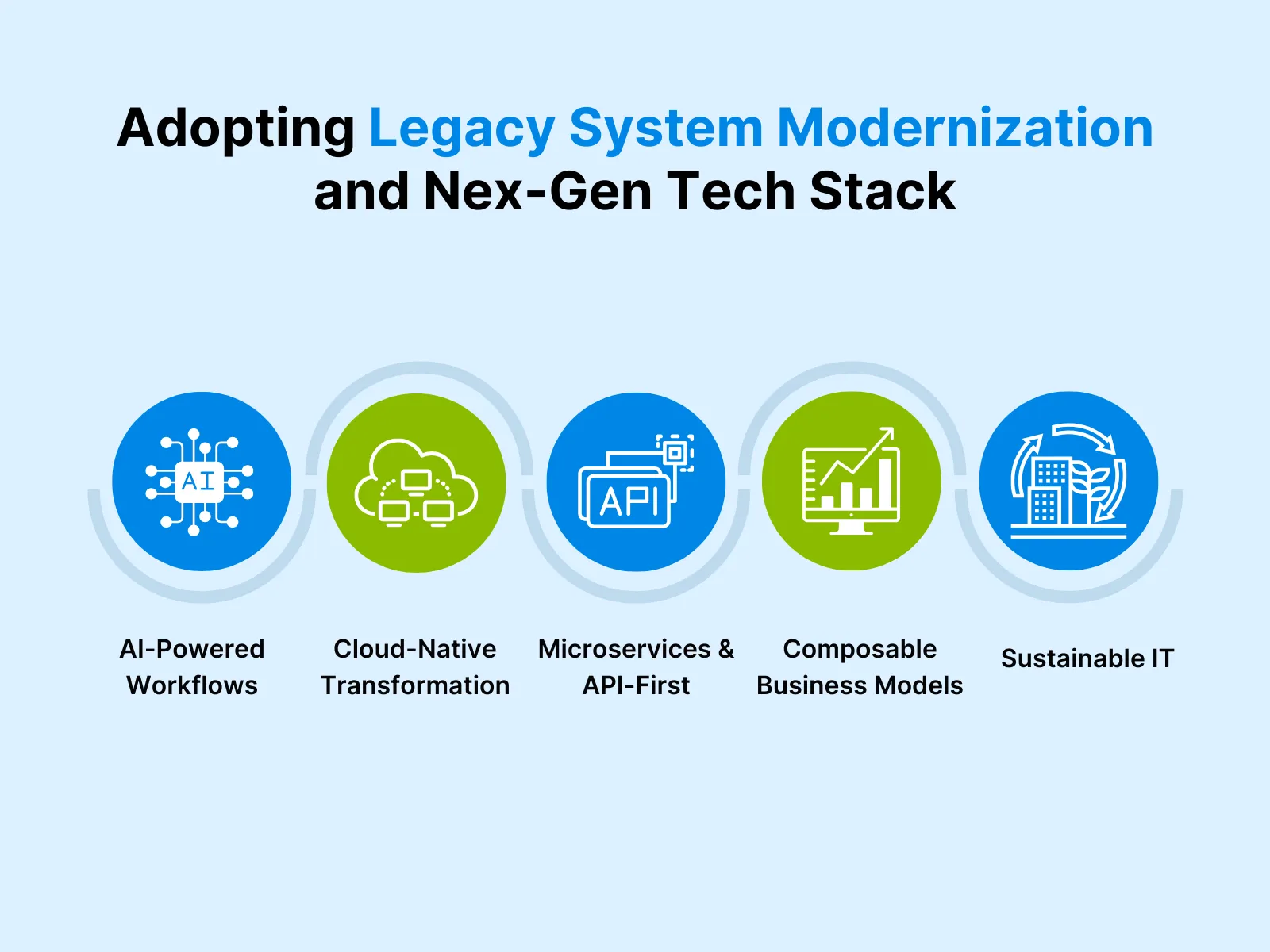Legacy System Modernization: The Key to Combating Core Business Risks in 2025
This blog is about legacy system modernization and its extensive role in combating business risks related to using legacy applications in 2025. Here, we will discuss why application modernization is necessary for enterprises to remain ahead of the competition.

Let’s face the truth. Today several companies are secretly losing billions of dollars all because of one single reason — they are still using legacy systems. These outdated systems have turned out to become graveyards or abandoned cities, which once thrived like a hub of core functionalities, and are now crumbling under the weight of obsolescence. While they may still function, their hidden costs silently drain billions and become the biggest obstacle to enhancing business scalability.
To put forth, we came across a WSJ CIO Journal Article about how companies become prisoners of legacy systems The article supported our point of view that many long-established companies still rely on decades-old software, once cutting-edge but now outdated.
The viable solution is integrating legacy system modernization—embracing cloud-native architectures, AI-driven automation, and microservices-based frameworks. Businesses must look to shed outdated tools, unlock agility, ensure robust security, and drive innovation.
Organizations must learn lessons from the past about how top-notch brands and applications failed to sustain steep market competition because they refused to innovate and modernize strategies and move ahead with time.
One such example is that of Blockbuster which failed to embrace digital streaming and invest in technology, giving way to Netflix to dominate the OTT and live streaming market. Another eye-opening example is that of photography giant Kodak as it did not migrate from traditional film photography to digital photography at the right time.
Legacy systems aren’t just outdated—they’re expensive. They create operational inefficiencies, increasing overhead costs while slowing down productivity. Their inability to integrate with modern AI, automation, and cloud solutions prevents enterprises from leveraging data-driven insights and streamlined workflows.
Additionally, compliance risks and security vulnerabilities expose businesses to cyber threats, regulatory penalties, and reputational damage. Hence, legacy applications are technological burdens and a silent financial drain that prevents enterprises from scaling. The choice therefore is clear and yours—modernize or perish.
Not Implementing Legacy System Modernization Leads to Cybersecurity Breaches
Do you remember the Log4j vulnerability that shook the cybersecurity industry late in 2021? Legacy systems that run on older and unsupported versions of operating systems and software tools become prone to critical security vulnerabilities. They are exposed to patches easily targeted by attackers to access sensitive data or disrupt operations.
Thus, legacy applications are cybercriminals’ playground and a ticking timebomb for any business domain, offering an open invitation to exploit weaknesses with outdated encryption, unpatched vulnerabilities, and obsolete frameworks. These systems lack vendor support, leaving organizations exposed to ever-evolving cyber threats.
The Biggest Cybersecurity Breaches Caused By Legacy Systems
To explain this further, we can cite the example of the most infamous breach in history, the Equifax Data Breach (2017), which was a direct result of legacy vulnerabilities. This single oversight led to the exposure of 147.9 Americans and 15.2 million British citizens' records, according to Wikipedia, costing Equifax a whopping $575 million in settlements and remediation.
Another dark horror story related to legacy systems is the WannaCry Ransomware Attack (2017) which exploited outdated Windows systems, crippling businesses, hospitals, and government agencies worldwide.
How Modern Cybersecurity Shields Your Business
We can say that companies that rely on outdated software are sitting on ducks. However, implementing AI-powered cybersecurity can help address such issues by using predictive threat detection. It analyzes the threat patterns to identify and neutralize risks before they escalate. Also, by integrating Zero Trust Architecture (ZTA), organizations can look to mitigate blind trust and enforce strict identity verification and encryption policies.
By modernizing legacy systems, businesses not only safeguard sensitive data but also fortify resilience against evolving cyber threats. Cybercriminals thrive on stagnation—if your software isn’t evolving, neither is your security.
Fortify and Bolster Cybersecurity With Legacy Application Modernization
Implement AI-powered encryption and threat detection
Implement Legacy System Modernization to Harness AI Innovation or Remain Obsolete
You must have heard of the popular phrase progress or perish, and this comes quite true with organizations using obsolete technology and tools. Today, AI/ML development services are automating and redefining business processes, enabling them to harness predictive analytics, personalize user experience, and enhance decision intelligence.
From optimizing the supply chain process to setting dynamic pricing, and fraud detection, AI is helping enterprises gain an edge over their competitors. On the other hand, legacy systems are regarded as bottlenecks to digital transformation. They are based on monolithic architectures, which do not allow APIs to become flexible and scalable, making it difficult to connect with modern cloud services or third-party apps.
AI and cloud engineering offer seamless real-time data processing and exchange, streamline workflows and strive for enhanced innovation. However, legacy applications often operate in batch-processing mode, failing to capture real-time insights. This results in delayed decision-making, missed opportunities, and suboptimal customer experiences.
Scalability has also been an impediment. While modern cloud infrastructure and architectures are providing agility and cost savings, the traditional on-premise cloud model demands improved maintenance and infrastructural investment. Also, they cannot scale operations, restricting businesses from adopting AI-based solutions like Generative AI for content automation and IoT for connected operations.
Monolithic architecture gets entrapped in rigid structures, leading to delayed deployment cycles. Hence, they are different from microservices architectures that provide for modular development and continuous deployment. Legacy systems create silos and hinder applications from integrating innovative technologies seamlessly.
Organizations that fail to modernize risk falling behind as competitors embrace AI-powered transformation. Enterprises adopting cloud-native, AI-integrated ecosystems are gaining a competitive advantage by driving efficiency, enhancing customer engagement, and accelerating time to market. Meanwhile, legacy-bound businesses remain constrained, missing out on game-changing innovations that define the future of digital enterprises.
Developers Want to Work With Advanced and Tech-Friendly Legacy System Modernization
In today's rapidly evolving technological landscape, top-tier tech talent is increasingly reluctant to work with outdated systems. Modern-day developers are drawn more to legacy application modernization and cloud computing environments that leverage microservices and API-first architectures. Thus, they do not want to work with antiquated legacy systems and technologies like COBOL and Delphi, which hampers their productivity.
Outdated systems often require manual processes, leading to operational inefficiencies. Recent studies have also shown that legacy tech systems have limited data access and delay decisions due to manual interventions. Such environments stifle innovation and deter developers who thrive on agility and modern tools.
The priorities of new-age developers are clear; they seek to work on advanced platforms and application modernization services, utilizing microservices, and adopt an API-first approach. It allows for increased app scalability and developer skillset. Companies that still cling to the old-school methods of the 2000s face intricate challenges of hiring and retaining the right talents.
Phuong Anh International JSC
One of the best real-life case studies of a Vietnamese manufacturing company Phuong Anh International JSC, which reported a $16 million profit-loss discrepancy due to outdated systems and inexperienced staff. Initially, the company reported a profit of VND 106 million, but when it was audited, it turned into a loss of nearly VND 290 million.
Ford Motors
The second example that can be put forth is that of the classic American car manufacturer Ford which thought of integrating digital transformation into the production process and created a new segment called Ford Smart Mobility. However, an article published in Forbes highlights that the company failed to integrate the new segment properly into the rest of the manufacturing unit.
These scenarios highlight a critical insight: modernization efforts must prioritize not just technological upgrades but also the needs and expectations of the workforce. By investing in legacy application modernization, organizations can attract and retain innovation-driven developers, ensuring sustained growth and competitiveness in the market.
The Tech Debt Black Hole: Why Delaying Modernization Will Cost You 10x More Later
Every delay in upgrading a system adds to technical debt, creating a growing burden on businesses. Instead of focusing on innovation, teams are trapped in endless cycles of fixing outdated software, applying patches, and maintaining fragile infrastructure. What seems like a short-term cost-saving decision quickly becomes an expensive long-term liability.
Continuous Patching and Workarounds
Old codebases demand constant firefighting. Engineers spend their time building workarounds and debugging instead of delivering new features. Legacy systems are often incompatible with modern integrations, forcing businesses to rely on inefficient, costly manual processes. This slows down operations, reduces competitiveness, and frustrates developers, leading to higher attrition rates.
The longer companies hold onto legacy software, the more expensive it becomes. According to industry research, businesses can end up spending 10 times more on maintaining outdated systems than it would cost to modernize. Hidden costs include security vulnerabilities, compliance risks, and lost revenue due to system failures.
What’s the Iceberg Analogy?
The iceberg analogy perfectly illustrates this problem. On the surface, businesses see only visible expenses—license renewals, server costs, and occasional upgrades. However, beneath the surface lies a much larger issue: scalability challenges, security risks, and reduced agility. These hidden costs accumulate over time, making it increasingly difficult to pivot, innovate, or integrate emerging technologies.
Delaying modernization is like ignoring a sinking ship. Patching holes might keep it afloat for a while, but eventually, the weight of technical debt will drag the entire business down. The longer companies wait, the fewer options they have—until modernization is no longer a choice but a crisis response.
Don’t Let Your Business Fall into Technical Debt Choose Legacy Modernization
So wait no more and implement legacy application modernization
Future-Proofing: Adopting Legacy System Modernization and Nex-Gen Tech Stack

Legacy systems are rapidly becoming obsolete as enterprises embrace next-gen technologies. AI-driven automation, cloud-native architectures, and modular designs are reshaping business operations. To stay competitive, organizations must adopt a future-proof tech stack that enhances agility, efficiency, and sustainability in a digital-first world.
AI-Powered Workflows
Modern enterprises are looking to hire AI developers to embrace AI-driven automation to eliminate inefficiencies and optimize workflows. AI-powered systems continuously learn and adapt, reducing manual interventions and accelerating decision-making. From predictive analytics to intelligent process automation, AI enhances productivity, lowers operational costs, and ensures business agility.
Cloud-Native Transformation
Shifting to cloud-native and serverless architectures is no longer optional—it’s essential. Kubernetes-based platforms enable seamless scalability, high availability, and cost-efficient resource utilization. Organizations leveraging cloud-native solutions gain faster deployment cycles, improved security, and enhanced resilience, ensuring they remain competitive in an increasingly digital economy.
Microservices & API-First Architecture
Monolithic applications struggle to keep pace with modern demands. Microservices and API-first architectures promote modular, scalable, and easily maintainable enterprise applications. With independent services communicating through well-defined APIs, businesses achieve greater flexibility, faster innovation cycles, and seamless integration with third-party ecosystems.
Composable Business Models
Enterprises must be agile to respond to market shifts, and composable architectures make that possible. Headless and modular frameworks enable businesses to assemble, reconfigure, and scale their digital services without disrupting core operations. Whether integrating new payment solutions or adopting AI-driven customer engagement tools, a composable strategy fosters rapid innovation and market adaptability.
Sustainable IT
Sustainability is no longer just a corporate responsibility—it’s a competitive advantage. Energy-efficient cloud platforms, carbon-aware computing, and green data centers are replacing power-hungry legacy infrastructure. By investing in sustainable IT, businesses reduce their carbon footprint while lowering energy costs, ensuring compliance with evolving environmental regulations.
The modern enterprise stack is not just about performance—it’s about survival. Organizations that fail to adopt AI-powered automation, cloud-native architectures, microservices, and sustainable IT risk obsolescence. Future-proofing technology and modernizing legacy applications today ensures long-term agility, efficiency, and competitive advantage in a digital-first world.
The CEO’s Dilemma – Adapt or Vanish?
The biggest threat to businesses in 2025 isn’t competition—it’s stagnation. Companies that resist modernization risk falling behind, while those that embrace next-gen technologies will redefine their industries. The pace of digital transformation is accelerating, and enterprises that fail to adapt will struggle to remain relevant.
Legacy software is no longer just an IT concern—it’s a company-wide risk. Outdated systems slow innovation, create security vulnerabilities, and make it harder to attract top talent. Skilled professionals prefer working with cutting-edge technologies, and businesses clinging to outdated infrastructure will face retention challenges.
Modernization isn’t just an upgrade; it’s a strategic necessity. AI-driven workflows, cloud-native architectures, and microservices empower businesses to scale, innovate, and stay resilient in an unpredictable market. Organizations that invest in future-proof solutions today will gain a competitive edge, ensuring long-term growth and stability.
The choice is clear: evolve or risk extinction. The companies that lead tomorrow’s market will be those that take decisive action today. CEOs must recognize that technology isn’t just a tool—it’s the foundation for sustainable success in the digital era.
FAQs
Legacy systems pose security vulnerabilities, slow down innovation, and increase operational costs. They lack scalability, struggle with integration, and create compliance risks. Outdated software hinders digital transformation, limits agility, and affects customer experience, making businesses less competitive in a rapidly evolving market.
Legacy system modernization is the process of upgrading outdated software, infrastructure, and architectures to improve efficiency, security, and scalability. It involves migrating to cloud-native solutions, adopting microservices, and integrating AI-driven automation, ensuring businesses stay agile, competitive, and aligned with modern technological advancements.
AI/ML services enhance legacy modernization by automating workflows, optimizing decision-making, and enabling predictive analytics. These technologies improve efficiency, personalize customer interactions, and reduce operational costs. AI-driven insights help businesses streamline processes, detect risks, and enhance scalability for long-term digital transformation.
The cost of modernization depends on factors like system complexity, cloud migration, and technology adoption. At TrooTech, we offer tailored solutions, optimizing expenses while ensuring scalability, security, and performance. Businesses gain long-term value through reduced maintenance costs, enhanced efficiency, and future-ready infrastructure.
TRooTech specializes in modernizing legacy applications with scalable, secure, and AI-powered solutions. With deep expertise in cloud migration, microservices, and automation, TrooTech ensures seamless transformation, minimizing downtime. Businesses benefit from enhanced agility, reduced risks, and a technology stack aligned with future digital demands.

